Start 14-Day Trial Subscription
*No credit card required
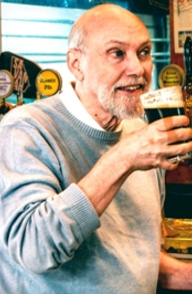
Top Rated Beers of 2014
If one wanted to write an ode to beer styles, our top rated beers of 2014 would make a good starting point. There’s a very engaging pale beer, a Kölsch, and exemplars of some other classic styles – English Brown and Vienna Lager plus London Porter and Belgian Dubbel.
Then there’s an Oude Bruin. After drinking this longstanding offering from East Flanders, blended anew each year, one wonders why the current rush toward sours took so long.
In addition to the styles born in the cradles of beer (a couple of which were brewed in Virginia and California), the list also includes some newer models such as a Session IPA and a West Coast-style IPA – the latter being brewed in the Midwest. There are a couple of American radicals – a hoppy, high gravity Baltic Porter and a similarly inclined Black IPA.
If you hosted a party and served these ten beers, we suspect it would be a big success. If you added all the brewers of these beers to the guest list, the gathering would likely be a huge, stonking success.
OK, so maybe we’ve segued into a flight of fancy. With all due respect, in lieu of one of the world’s more interesting parties, our experienced beer writers got in touch with the brewers to bring their comments directly to these pages – a world tour at your fingertips.
This process began, of course, with our expert reviewers, all of whom would know an outstanding beer even when blind-folded. As it was, they had a full view of the pour and were able to take notes –
but didn’t know which beer was being tasted when each score was assigned, only the style. They eyeballed, sniffed, swirled and quaffed before waxing poetic about their findings.
The results over the course of this year’s reviews were ten beers found to be world class. And that’s no flight of fancy.

1.
98
Wookey Jack
Issue 17, Fall 2014
Firestone Walker Brewing Company
Paso Robles, California
www.firestonebeer.com
Reviewed by: Phil Farrell
Style: Black IPA
Sometimes the uber types rule. They let those running the brewing process know when palates are satisfied – and when not.
Initially, Matt Brynildson, brewmaster at Firestone Walker, didn’t want to follow the herd and do a Black IPA. “Then we started thinking about rye and how its spicy grain character might play well with dark malts and pungent hop character,” he said. “Truth be known, Wookey Jack became a bit of a response to some of the feedback that we were getting from some uber beer geeks about not making our Union Jack and Double Jack IPAs hoppy enough.”
His answer became a superb example of the black variety of specialty IPAs. “I was thinking to myself, let’s take the gloves off and try to make a beer that is so dark and hop forward that even the Double IPA fans will be offended. We combined
two of the most dank and pungent hops in our arsenal and double dry-hopped this dark, rye infused beast.”
And the name? “Wookey reflects the idea of creating an extreme and somewhat unkept brew. I was affectionately envisioning the dreadlocked, baggy-dressed, herb wielding eccentrics that I run into at Phish shows around the country, who are often referred to as Wookies. Try as we might to go over the edge, we managed to produce a big, yet balanced hop-forward brew with a slightly shaggier mane than the rest of the Firestone Walker family.”
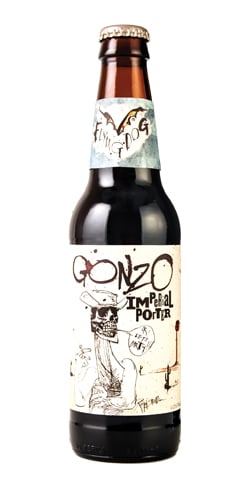
2.
98
Gonzo Imperial Porter
Issue 16, Fall 2014
Flying Dog Brewery
Frederick, Maryland
www.flyingdogbrewery.com
Reviewed by: Bob Townsend
Style: Imperial Porter
Lovers of the original gonzo journalist, Hunter S. Thompson, will embrace the dark, intoxicating beauty of Flying Dog Gonzo Imperial Porter. The potent, complex concoction was based on the Baltic porter style, and first brewed to celebrate Thompson, shortly after his death in 2005.
Eric Warner, the Flying Dog brewmaster-made-CEO, back before the brewery moved from downtown Denver to Frederick, Maryland, remembers designing the beer with Ryan Fox, the
head brewer at the time. “We defi nitely decided we should do a beer in his honor,” said Warner, who is now the brewmaster at Karbach Brewing Company in Houston. “And we’d been thinking about doing an imperial porter, anyway, so it just made sense.
“What more gonzo, in-your-face beer could you come up with? So we just sat down and wrote a recipe and brewed it up, gonzo-style. It was going to be a small batch one-off thing, but it got such amazing response, we decided to do it regularly.”
The intense, heavy hopping was schemed to cut through all the malt sweetness and high starting gravity, and it was fermented with a combination of ale and lager yeasts, Warner recalls.
Of course, Thompson’s artist sidekick, Ralph Steadman, created the perfect Gonzo label art, with a skeleton image announcing, “OK! Let’s Party!!” Later, in his 2006 book about Thompson, “The Joke’s Over,” Steadman wrote, “Gonzo is a strange kind of magic that appeals to the beast that lurks in the dark heart of most of us.”
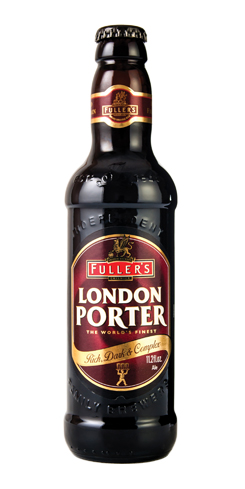
3.
97
London Porter
Issue 16, Fall 2014
Fuller’s Brewing
Chiswick, London
Imported by Paulaner HP USA
www.paulanerhpusa.com
Reviewed by: Gary Watkins
Style: Brown Porter
Fuller’s London Porter has become a much loved staple of the brewer’s range. It is fitting that the last of the traditional family owned breweries in London should produce a beer synonymous with the UK capital.
This style of beer and brewing at Fuller’s Griffin Brewery in Chiswick — six miles from the West End — have their origins in the 17th century. Fuller’s London Porter dates back only to the mid-1990s when it was conceived by then head brewer Reg Drury, but its roots are firmly in the past and was based on an early 20th Century recipe.
“It was a new recipe, but the brewing books we have here at Fuller’s from the distant past provided the inspiration,” said Georgina Young, the brewing manager at Fuller’s today. “The brown and crystal malts are what give London Porter its authentic smokey, chocolaty flavor.”
London Porter is a seasonal brew for the winter and spring, available predominantly in bottle and keg. There is, however, opportunity to sample it from the cask. “Every bottling run we produce a few firkins by hand, which normally go to special events or beer festivals,” said Young.
You won’t find London Porter at every Fuller’s pub, even on keg. That only adds to the mystique of a creamy brew that is both light on the palate and complex in flavor.
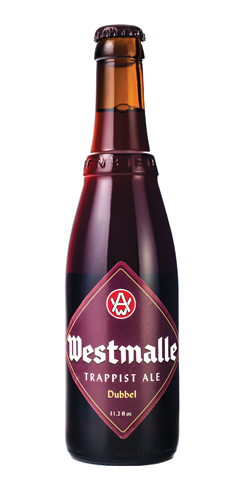
4.
97
Westmalle Dubbel
Issue 17, Winter 2014
Brewery Der Trappisten Van Westmalle
Westmalle, Belgium
Imported by Merchant du Vin
www.merchantduvin.com
Reviewed by: Owen Ogletree
Style: Belgian Dubbel
Located in northern Belgium, just a few miles from Antwerp, the picturesque Westmalle Trappist abbey is known as the producer of the world’s first tripel ale back in 1933, and many beer historians regard Westmalle’s earliest brown ale, first produced around 1855, as the original example of the dubbel style of beer.
Dubbels possess a rich brown hue, slight malt sweetness, subtle hops, caramel tones, complex notes of dark fruit and an ABV range of 6 to 7.5 percent. This original definitely ranks as a world-class example of the dubbel style.
Westmalle’s few remaining monks are quick to point out that they are Trappist monks first and brewers second. Westmalle’s farm, dairy, cheese factory and brewery exist to sustain the monks, maintain the abbey and benefit the community with charitable contributions. The abbey remains a quiet, secluded place of worship with no gift shop or visitor’s center. Thirsty pilgrims can enjoy the delicious Westmalle cheese and beers across the street from the abbey at the delightful Cafe Trappisten.
The monks respect time-honored brewing traditions. During a conference in Belgium not too long ago, for example, some brewers from that famed beer country suggested that bottle-conditioning might be outdated and too much work. Westmalle’s head brewer, Jan Adriaensens, is not often outspoken. But he chose to speak up in this instance. “We’ll keep bottle-conditioning,” he said. “It’s a part of what Westmalle is.’”
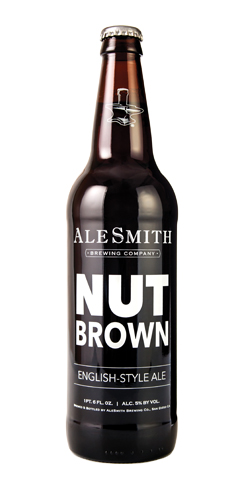
5.
96
Nut Brown Ale
Issue 16, Fall 2014
Alesmith Brewing Company
San Diego, California
www.alesmith.com
Reviewed by: Phil Farrell
Style: English Brown Ale
Imagine a beer worthy of an evening tossing darts in the back of the pub with ultimate beer guide author Michael Jackson. After a couple
of pints you can still close out 17s by hitting a triple – and then celebrate with another round.
Nut Brown Ale started life as a homebrew crafted by Alesmith founder Peter Zien as an English mild ale for a Southern California homebrewer’s festival in 1995. It was later brewed at Alesmith as Brownie, then Nautical Nut Brown before it settled into its current formulation. Although it grew in body and alcohol with each incarnation to its present 5 percent ABV, it is still the lowest alcohol beer Alesmith brews year-round.
“Although it started as a draft only selection for many years, we began bottling it in 2012 and it remains one of AleSmith’s most in-demand beers,” said Zien.
The beer performs the high wire balancing act of complexity without falling into the trap of being complicated. The aroma, flavor and mouthfeel emphasize the biscuit and light chocolate malt nuttiness over the subtle earthy hop notes. One can even pick up a hint of dark fruit as it warms. It finishes slightly dry but still crisp with a lingering aftertaste of earth and nuts – perfect for another round.

6.
96
Two Hearted Ale
Issue 17, Winter 2014
Bell’s Brewing Company
Kalamazoo, Michigan
www.bellsbeer.com
Reviewed by: Owen Ogletree
Style: American IPA
Two Hearted Ale, the flagship IPA of Bell’s Brewery, embodies a superb balance of powerful hops and sweet malt. Two Hearted uses only Centennial hops from the Northwest, which gives it a crisp, clean hop character of aromatic resins and grapefruit. The beer’s fi rm malt body and signature esters from the house yeast add further distinction.
The beer may never have existed without an extremely fortunate accident. Larry Bell started his brewery in the early 1980s with $200 his mother sent for his birthday. He got into the business to pioneer beers like Two Hearted Ale, but the fledgling brewery was underfunded. The year of 1988 brought a severe drought and malt prices skyrocketed beyond Bell’s budget. Bell even thought about bankruptcy. But when an attorney told him how much the fee would be to fi le his petition, he balked. “If I could afford to pay your fee,” he said, “I wouldn’t need to file bankruptcy.”
Just when the company seemed close to complete insolvency, a scrap broker offered him a whole rail car of malt with slight water damage for one-third the going price. A few buckets of wet malt were scooped off the top with the remainder being dry and usable. “This was top-of-the-line, Two-Row malt and I bought the lot of it,” Larry recalled. “We had malt stacked everywhere. It lasted us for a year, malt prices came back down, and we were able to save the business.” Fans of Two Hearted Ale, among other Bell’s beers, are quite grateful.
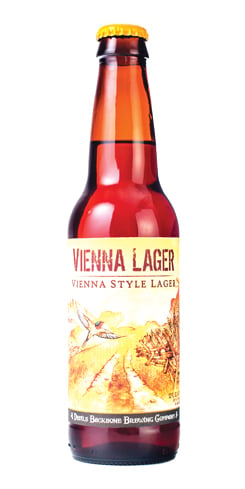
7.
96
Vienna Lager
Issue 17, Winter 2014
Devils Backbone Brewing Company
Lexington, Virginia
www.dbbrewingcompany.com
Reviewed by: Jonathan Ingram
Style: Vienna Lager
Here’s a Vienna Lager that scores well wherever it goes – in contests and reviews, in bottles and at the source – the Devils Backbone brewpub in Roseland, Virginia and the production brewery’s tap room in Lexington, Virginia.
Jason Oliver, the head brewer at Devils Backbone since the doors opened, spent six years at Gordon Biersch brewing German styles, but chose the Vienna Lager as a flagship once he moved. “There’s a certain amount of romance when you say Vienna. It conjures up something foreign and exotic. In your imagination, it can transport you to a different place.”
He chose to stay close to the style’s origins with his own intuitive variations, using a balance of roasted Pilsner and Vienna malts, plus some dark Munich and Caramel malts, enough malt to help bring out some complexity and sweetness without the more aggressive tastes of the marzens he brewed for many years. Since the crucial lagering was an expertise he had already mastered, Oliver’s version of Vienna Lager turned out to be very clean and drinkable due to its flavorful, malty emphasis. He ended up with an approachable yet sophisticated lager that works well with food.
Using ingredients from close to the source of the style’s origins in Europe helps sustain the beer’s quality. Once it was packaged, the Vienna Lager quickly became the company’s flagship brew and a favorite at beer festivals. It won gold at the World Cup and the GABF in 2012 and took a silver at this year’s GABF.

8.
96
Extended Play
Issue 15, Summer 2014
Lakefront Brewery
Milwaukee, Wisconsin
www.lakefrontbrewery.com
Reviewed by: Owen Ogletree
Style: Session IPA
Craving old-world, flavorful beer styles in a time when light lagers ruled the upper Midwestern landscape, Russ Klisch and his police officer brother Jim cobbled together the original, Frankenstein-like Lakefront Brewery on the banks of the Milwaukee River in 1987, complete with three old dairy tanks painted with the faces of the Three Stooges.
Lakefront has evolved into a personable and inventive cornerstone of Milwaukee’s craft beer landscape with the brewery’s early portfolio of classic, German-inspired recipes morphing in recent years into a wide array of imaginative ales and lagers.
The amazingly quaffable Extended Play India-style Session Ale, which took a gold medal at the Los Angeles International Beer Competition, comes in at 4.2 percent ABV. The goal, according to Russ and Jim, was to offer “all the hoppy goodness of a legit IPA but with less alcohol.”
An outstanding example of the trendy new Session IPA style, first launched across Lake Michigan at Founders Brewing Company, the Extended Play contains 38 IBUs, Two-Row pale malt, pale wheat and a touch of light and medium caramel malts.
Expect low bitterness with impressive aroma, flavor and finish coming from a hop palette of Willamette, Centennial, Chinook, Citra and Cascade – all added near the end of the boil and in the whirlpool. The delicate malt and caramel body provides the perfect backdrop for a blast of citrusy hop aftertaste.
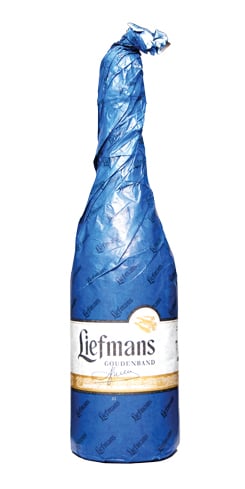
9.
98
Goudenband
Issue 16, Fall 2014
Liefmans
Oudenaarde, Belgium
Imported by Duvel Moortgat USA
www.duvel.com
Reviewed by: Osayi Endolyn
Style: Flanders Oude Bruin
Not every beer triggers excitement with its packaging, but the mauve blue, handwrapped tissue paper surrounding a bottle of Goudenband ranks high on the scale of anticipation.
There’s a reason for the selection of this tissue for this oud bruin, or old brown. Rosa Merckx, Belgium’s first female brewmaster and the driving force behind the line of Liefmans sour brews, was fond of using a color reference to describe the kind of beer she wanted to make. “Beer has a soul,” Merckx would say. “Good beer tastes ever so slightly mauve. Bad beer tastes blue.”
A complex beer, the pleasure of Goudenband (Gold Band) comes in waves: raisins, currant, tart apple and cherry, some barnyard. The layers seem endless.
Liefmans follows the sour beer tradition of fermenting in open vats and blending young beers with old. In addition to pitched yeast, airborne wild microflora mix freely here, allowing the beer to acquire lactic acid bacteria and the essence of the Oudenaarde terra. “The final beer is each time a little bit different,” said Marc Coesens, who directs the blending process. “A finished beer can have beers of one year, six months and much younger beers of let’s say one month. Pure expertise and handicraft!”
The caramelized malts common to oud bruin yield a nutty, chocolate base, smooth flavors that provide a palate-opening softness so the divine, dry acidity can shine through. At 8 percent, a bottle is clearly meant for sharing, but no enthusiast will blame you for keeping it to yourself.

10.
96
Sünner Kölsch
Issue 15, Summer 2014
Sünner Brauerei
Cologne, Germany
Imported by Artisanal Imports
www.artisanalimports.com
Reviewed by: Jonathan Ingram
Style: Kölsch
There’s nothing quite like drinking Kölsch in Cologne, the city of its origin. Served in a classic stang, Kölsch embodies some of the best attributes of ales and lagers. It is top-fermented – giving the beer a fruitiness – but lagered after fermentation, giving it a refreshing smoothness and drinkability.
In Cologne, a server will keep refi lling your stang and marking the number of pours on the beer mat, or coaster. Given the short, thin glass and the allure of the easy-drinking, highly aromatic beer, it’s easy to get quite convivial before placing the coaster on top of the stang to signal you’re ready to stop and pay.
Sünner is the oldest continuously operating Kölsch brewery in Cologne and continues to stick to the time-honored methods of using open vats in its long established deep cellars for fermentation before lagering. It’s a method that wins fans out side the city and country of origin.
“We are special, because of our history,” said Astrid Schmitz-Dumont, the company’s sixth generation director. “We are the oldest Kölsch brewery in the world and a real craft brewer by nature. And that helps for being successful abroad.”
In Cologne and Germany, the competition from other brewers of Kölsch is quite fierce, particularly when it comes to pricing. Because it continues with time-honored methods, Sünner sustains its tradition by exporting. That includes special batches made for America.
“For the U.S. market we do a stronger Kölsch with 5.3 percent alcohol,” said Franz Erbelding, the head brewer. “That makes a good difference to the other Kölsch from Cologne. We are a bit more hoppy and very crispy.”



